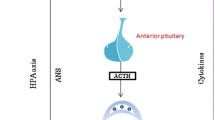Abstract
Malathion is a widely used organophosphate pesticide that modulates immune function at noncholinergic doses. Previous studies showed that this alteration in immune function was the result of enhanced macrophage function. In the present study, the effects of low doses of purified malathion (as low as 0.25 mg/kg malathion) administered orally to mice enhanced the respiratory burst of peritoneal cells. Microscopic examination of the peritoneal cells showed that mast cells were degranulated within 4 hr after malathion administration. The amount of β-hexosaminidase, an enzyme released upon immunologic degranulation of mast cells, in the peritoneal lavage fluid of malathion-treated mice was also significantly elevated with 4 hours after malathion administration. Treatment of RBL-1, a rat basophilic cell line, cells with malation, parathion or paroxonin vitro also led to the release of β-hexosaminidase with paraoxon being the most potent. Further examination of the peritoneal cells of malathion-treated mice showed that the percentage of phagocytic peritoneal cells ingesting mast cell granules and the number of granules ingested per cell were elevated. These data suggest that malathion may enhance the respiratory burst of peritoneal cells through degranualtion of peritoneal mast cells and the subsequent exposure to peritoneal cells to mast cell mediators.
Similar content being viewed by others
References
N. M. Weeks, M. A. Lawson R. A. Angerhofer, C. D. Davenpod and N. E. Pennington,Preliminary assessment of the acute toxicity of malathion in animals. Arch. Environ. Contam. Toxicol.5, 23 (1977).
N. Umetsu, N. M. Mallipudi, R. F. Toia, R. B. March and T. R. Fukuto,Toxicologic properties of phosphorothioate and releated esters present in organophosphate insecticides. J. Toxicol. Environ. Health.7, 481 (1981).
N. M. Mallipudi, R. E. Talcott, A. Ketterman and T. R. Fukuto,Properties and inhibition of rat malathion carboxylesterases. J. Toxicol. Envir. Health6, 583 (1980).
F. W. Plapp and J. E. Casida,Hydrolysis of the alkyl-phosphate bond in certain dialkyl aryl phosphorothioate insecticides by rats, cockroaches and alkali. J. Econ. Entomol.51, 800 (1958).
G. B. Koelle,Neurohumoral transmission and the autonomic nervous system. InThe pharmacologic basis of therapeutics. (Eds. R. Goodman and A. Gilman) pp. 21 (1980).
G. P. Casale, S. D. Cohen and R. A. diCapua,The effects of organophosphate-induced cholinergic stimulation on the antibody response to sheep erythrocytes in inbred mice. Toxicol. Appl. Pharmacol.68, 198 (1983).
T. F. Desi, G. Varga and C. G. Judet,Immune suppressive effects of chlorinated hydrocarbons and organic phosphate pesticide administration. Egesizegtudomany20, 358 (1976).
K. E. Rodgers, N. Leung, C. F. Ware, B. H. Devens and T. Imamura,Lack of immunosuppressive effects of acute and subacute administration of malathion on murine cellular and humoral immune responses. Pestic. Biochem. Physiol.25, 358 (1986).
K. E. Rodgers and D. D. Ellefson,Modulation of respiratory burst activity and mitogenic response of human peripheral blood mononuclear cells and murine splenocytes and peritoneal cells by malathion. Fund. Appl. Toxicol.14, 309 (1990).
R. E. Duque, S. H. Phan, J. L. Hudson, G. O. Till and P. A. Ward,Functional defect in phagocytic cells following thermal injury: Application of flow cytometric analysis. Amer. J. Pathol.118, 116 (1985).
R. D. Higginbotham, T. F. Doughtery and W. S. S. Jee,Fate of shed mast cell granules. Proc. Soc. Exp. Biol. Med.92, 256 (1956).
L. B. Schwartz, K. F. Austen and S. I. Wasserman,Immunologic release of β-hexosaminidase and β-glucuronidase from purified rat serosal mast cells. J. Immunol.123, 1445 (1979).
K. E. Rodgers and D. D. Ellefson,Effects of acute administration of O,O,S-trimethyl phosphorothioate on the respiratory burst and phagocytic activity of splenic and peritoneal leukocytes. Agents and Actions24, 152 (1988).
N. Umetsu, F. H. Grose, R. Allayhari, S. Abu-E-Haj and T. R. Fukuto,Effect of impurities on mammalian toxicity of technical malathion and acephate. J. Agric. Food Chem.25, 956 (1977).
W. Kazimierczak, H. L. Muir, D. W. MacGlashan and L. M. Lichtenstein,An antigen-activated DFP-inhibitable enzyme controls basophil desensitization. J. Immunol.,132, 399 (1984).
H. L. Meier, C. L. Gross and B. Papirmeister.,Regulation by serine esterase of histamine release by human leukocytes. Direct release by the serine esterase inhibitors diisopropyl fluorophosphate (DFP) and soman (GD). Biochemical Pharmacology35, 4125 (1986).
C. A. Gespach, J. M. Courillon-Mallet, H. Launay, H. Cost and J. P. Abita,Histamine receptor activity and histamine metabolism in human U937 monocyte-like cells and human peripheral monocytes. Agents and Actions18, 124–128 (1986).
J. R. Yoffe, D. J. Taylor and D. E. Wooley,Mast-cell products and heparin stimulate the production of mononuclear cell factor by cultured human monocytes/macrophages. Biochem. J.230, 83–88 (1985).
R. M. Schultz, J. D. Papamatheakis and M. A. Cherigos,Interferon: and inducer of macrophage activation by polyanions, Science197, 674 (1977).
U. Lindahl, H. Pertoft and R. Selgelid,Uptake and degradation of mast cell granules by mouse peritoneal macrophages. Biochem. J.182, 189 (1979).
T. H. Milby and W. L. Epstein,Allergic contact sensitivity to malathion. Arch. Envir. Health9, 434 (1964).
J. R. Cushman and J. C. Street,Allergic hypersensitivity to the insecticide malathion in Balb/c mice. Toxicol. Appl. Pharmacol.70, 29 (1983).
Author information
Authors and Affiliations
Additional information
Supported by PH5 E04337.
Rights and permissions
About this article
Cite this article
Rodgers, K., Ellefson, D. Mechanism of the modulation of murine peritoneal cell function and mast cell degranulation by low doses of malathion. Agents and Actions 35, 57–63 (1992). https://doi.org/10.1007/BF01990952
Received:
Accepted:
Issue Date:
DOI: https://doi.org/10.1007/BF01990952




